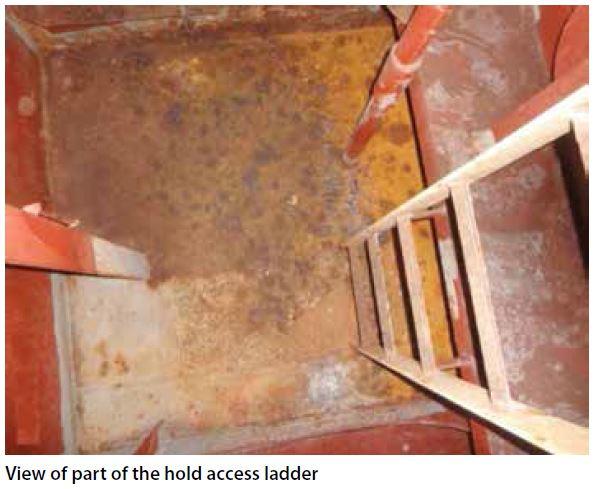201761 Hold access ladder is an enclosed space
Edited from official report no 55E/2014, Republic of Cyprus Marine Accident & Incident Investigation Committee
A loaded bulk carrier berthed at port for discharge operations. Holds three and five were discharged of the ‘green delayed petroleum coke’ without incident. One of the officers decided to check for damage in number five hold. He instructed the deck crew member who had the keys to open the entrance hatchway door of hold five. Equipped with a VHF radio, he then entered via the cofferdam enclosed stairs.
Some time later the chief officer tried to contact the officer (now in the hold) via VHF without success.
He asked a deck rating to find the officer. The deck rating went to hold five and looked over the hatch coaming, but did not see the officer. He then went to the hold’s aft entrance hatchway and shouted, but there was no reply. He entered and proceeded down the ladder. When he arrived on the first platform he realised that the officer was lying face down on the next platform. He immediately called for help on VHF and, assuming the officer had slipped on the ladder and fallen, proceeded down to help him. When the deck rating reached the victim he too collapsed.
The chief officer heard the call for assistance and assumed a fall; he ordered the gangway crew member to investigate. The crew member entered the hold access and saw the two collapsed men; descending the stairs, he too lost consciousness and fell down on the first platform. The C/O arrived soon afterwards and seeing all the unconscious men on the ladder platforms raised the alarm. Breathing apparatus (BA) was prepared and the three men evacuated from the hold access ladderway.
Two crew were revived but the officer was later pronounced dead.
The official investigation found, among other things:
- A contributing factor to the accident was the perceived absence of threat within the enclosed space that contained the hold ladder.
- Despite posted safety signs warning crew to confirm oxygen content of the space before entering, this procedure was not followed.
Lessons learned
- Some enclosed spaces, such as a hold access ladder, may seem less risky to mariners due to their familiarity. Never fall into this trap. Treat all enclosed spaces equally by testing for oxygen content before entering and deploying the full enclosed space procedure each time.
- Identify all enclosed spaces on board your vessel and mark them as such.
- Warning signage is a preliminary barrier to protect against risks in enclosed spaces, but it is not sufficient on its own. Correct entry into enclosed spaces must be an integral part of the culture in the company and on the vessel.
- Never rush into a confined space to rescue a crew member who has collapsed. Call for help and put your enclosed space rescue routine into effect.

